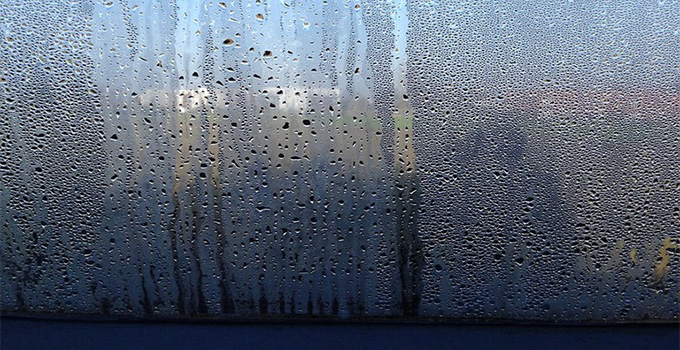Condensation on glass window panes is a natural phenomenon that cannot be completely avoided, no matter how well insulated your house or how efficient your double-glazing is. This blog post explains how and why condensation occurs, and what you can do to control it.

1. Why is there condensation on my windows?
Condensation occurs when warm, moisture-laden air meets a cool surface such as glass – the change in temperature causes the moisture to condense onto that surface in the form of water droplets. Colder external temperatures during winter months combined with heated internal temperatures will result in larger amounts of condensation.
1.1 Is condensation harmful?
Although the condensation itself is not harmful, it is unattractive and can damage windows. Condensation running down onto wooden window frames can encourage mould growth, and the continual build up of water will eventually rot the frame. Condensation is also evidence of a humid atmosphere which is, in itself, unhealthy and can exacerbate respiratory problems, allergies and other conditions.
2. How can I prevent condensation?
The key to preventing condensation is to control humidity and temperature. The ideal humidity level is between 40-50% when air temperature is 20ºC. If condensation is starting to become a problem, try the following:
Increase ventilation: It is necessary to refresh warm moist air with dry air, so air rooms for five to 10 minutes, several times a day. Make sure to air the house evenly – don’t just open kitchen or bathroom windows, as this will simply move the air with the highest humidity into (rather than out of) the house. Air your house even if it is raining - the warm internal air will still hold more moisture than the cold air outside.
Trickle ventilation: If your windows have trickle ventilators – narrow slits placed in the frame – then keep these open all day (it is possible to retro-fit trickle ventilators into VELFAC windows if necessary). Make sure other air vents – such as air bricks – are large enough, and are not blocked.
Ventilate well when cooking and bathing: If you have an extractor hood in your kitchen, or fan in your bathroom, then turn these on as soon as you start cooking or bathing and keep them running for 10 to 15 minutes after you have stopped. If you don’t have such extractor fans, then these rooms have to be aired more frequently.
Dry clothes outside: Whenever possible, avoid drying clothes inside the house. If you use a tumble drier, make sure the warm air is vented outside.
2.1 Managing other less obvious sources of humidity.
People, pets and houseplants: Every living thing within a building adds to the overall humidity; for example, a single adult will produce around two litres of water vapour a day. Ventilation should take account of the number of people, pets and houseplants living together.
Lower night time temperatures and unheated rooms: Cold air can’t hold as much moisture as warm air, so if temperatures drop – when heating is turned off – then the cooling air will deposit moisture, which is why morning condensation is common.
An empty house: If your house has been unoccupied for any length of time (while you are on holiday, for example), then walls, furniture, carpets and so on will have absorbed moisture while the house was unheated, especially if the weather was damp when you were away. For up to 10 days after you return, try to keep windows open as much as possible while raising the internal temperature by 4-5ºC.
3. Condensation has suddenly become a problem - why?
It’s not unusual for windows which have been condensation free to suddenly mist up on a regular basis. If you have experienced such a change, then it might be the result of one – or a combination – of the following causes. In all cases, you will need to ensure that you ventilate internal spaces more regularly.
You have recently placed plants on the window cill: Plants naturally produce moisture which will cool against cold window panes.
You have new windows: New low-energy glazing improves insulation so internal and external temperatures become more apparent.
You have recently extended part of your house, or moved into a new build property:
New plaster, cement, concrete and paint all contain a lot of moisture which takes time to evaporate completely – possibly up to a year.
Onset of winter: Condensation is at its worst when autumn turns to winter. Temperatures start to fall, especially overnight, and heating is turned on indoors. The building structure, unheated all summer, is relatively cool but as it heats up it emits moisture into the air.
Underfloor heating: Condensation can result if you have recently replaced radiators with underfloor heating, as radiators cause warm air to rise and circulate. This together with the removal of radiators underneath windows, can increase condensation.
Deeper windowsills or new curtains: If you have installed windows with deeper sills, or hung thicker curtains, then heat from nearby radiators may not be able to reach and warm the glass pane, thereby encouraging condensation.
4. Additional concerns
If you have condensation outside your windows, this is nothing to worry about and demonstrates the excellent insulation properties of your double-glazed units.
Traditional double-glazing still transmits heat through both panes making the outer pane too varm for external condensation to occur – low energy glazing keeps this heat inside the room.
If you have condensation between the panes, this means that the double-glazed seal is broken and moisture has entered the space between the panes. The insulating properties of the window are not compromised, but the resulting thin grey film of condensation is unattractive – it prevents light from entering and you can’t see out properly. Check your window manufacturer’s guarantee if this occurs (VELFAC low energy units are guaranteed for 12 years).